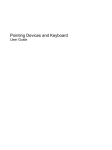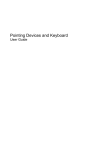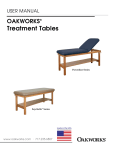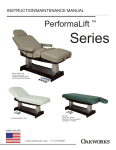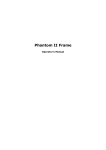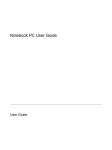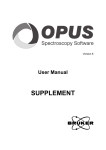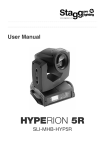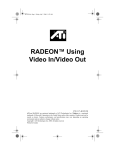Download TouchPad and Keyboard
Transcript
TouchPad and Keyboard User Guide © Copyright 2007 Hewlett-Packard Development Company, L.P. Windows is a U.S. registered trademark of Microsoft Corporation. The information contained herein is subject to change without notice. The only warranties for HP products and services are set forth in the express warranty statements accompanying such products and services. Nothing herein should be construed as constituting an additional warranty. HP shall not be liable for technical or editorial errors or omissions contained herein. Second Edition: August 2007 First Edition: April 2007 Document Part Number: 439826-002 Product notice This user guide describes features that are common to most models. Some features may not be available on your computer. iii iv Product notice Table of contents 1 Using the TouchPad Setting TouchPad preferences ............................................................................................................. 2 Connecting an external mouse ............................................................................................................. 2 2 Using the keyboard Using hotkeys ....................................................................................................................................... 3 Displaying system information (fn+esc) ............................................................................... 4 Opening Help and Support (fn+f1) ....................................................................................... 4 Opening the Print Options window (fn+f2) ........................................................................... 4 Opening a Web browser (fn+f3) .......................................................................................... 5 Switching the screen image (fn+f4) ..................................................................................... 5 Initiating Hibernation (fn+f5) ................................................................................................ 6 Initiating QuickLock (fn+f6) .................................................................................................. 6 Decreasing screen brightness (fn+f7) .................................................................................. 6 Increasing screen brightness (fn+f8) ................................................................................... 6 Playing, pausing or resuming an audio CD or a DVD (fn+f9) .............................................. 6 Stopping an audio CD or a DVD (fn+f10) ............................................................................ 6 Playing previous track or section of an audio CD or a DVD (fn+f11) ................................... 6 Playing next track or section of an audio CD or a DVD (fn+f12) ......................................... 7 3 Using the keypads Using the embedded numeric keypad .................................................................................................. 9 Enabling and disabling the embedded numeric keypad ...................................................... 9 Switching key functions on the embedded numeric keypad ................................................ 9 Using an optional external numeric keypad ......................................................................................... 9 4 Cleaning the TouchPad and keyboard Index ................................................................................................................................................................... 11 v vi 1 Using the TouchPad The following illustration and table describe the computer TouchPad. Component Description (1) ● Blue: TouchPad is enabled. ● Amber: TouchPad is disabled. TouchPad light (2) TouchPad* Moves the pointer and selects or activates items on the screen. (3) TouchPad horizontal scroll zone* Scrolls left or right. (4) Left TouchPad button* Functions like the left button on an external mouse. (5) Right TouchPad button* Functions like the right button on an external mouse. (6) TouchPad vertical scroll zone* Scrolls up or down. (7) TouchPad on/off button Enables/disables the TouchPad. *This table describes factory settings. To view and change TouchPad preferences, select Start > Control Panel > Hardware and Sound > Mouse. To move the pointer, slide your finger across the TouchPad surface in the direction you want the pointer to go. Use the left and right TouchPad buttons like the corresponding buttons on an external mouse. To scroll up and down using the TouchPad vertical scroll zone, slide your finger up or down over the vertical white line. To scroll left and right using the TouchPad horizontal scroll zone, slide your finger left or right over the horizontal white line. 1 NOTE: If you are using the TouchPad to move the pointer, you must lift your finger off the TouchPad before moving it to the scroll zone. Simply sliding your finger from the TouchPad to the scroll zone will not activate the scrolling function. Setting TouchPad preferences Use Mouse Properties in Windows® to customize settings for pointing devices, such as button configuration, click speed, and pointer options. To access Mouse Properties, select Start > Control Panel > Hardware and Sound > Mouse. Connecting an external mouse You can connect an external USB mouse to the computer using one of the USB ports on the computer. A USB mouse can also be connected to the system using the ports on an optional docking device or expansion product. 2 Chapter 1 Using the TouchPad 2 Using the keyboard Using hotkeys Hotkeys are combinations of the fn key (1) and either the esc key (2) or one of the function keys (3). The icons on the f1 through f12 keys represent the hotkey functions. Hotkey functions and procedures are discussed in the following sections. Function Hotkey Display system information. fn+esc Open Help and Support. fn+f1 Open the Print Options window. fn+f2 Open a Web browser. fn+f3 Alternate between computer display and external display. fn+f4 Initiate Hibernation. fn+f5 Initiate QuickLock. fn+f6 Decrease screen brightness. fn+f7 Increase screen brightness. fn+f8 Play, pause, or resume an audio CD or a DVD. fn+f9 Stop an audio CD or a DVD. fn+f10 Using hotkeys 3 Function Hotkey Play the previous track or section on an audio CD or a DVD. fn+f11 Play the next track on an audio CD or a DVD. fn+f12 To use a hotkey command on the computer keyboard, follow either of these steps: ● Briefly press the fn key, and then briefly press the second key of the hotkey command. – or – ● Press and hold down the fn key, briefly press the second key of the hotkey command, and then release both keys at the same time. Displaying system information (fn+esc) Press fn+esc to display information about system hardware components and the system BIOS version number. In the Windows fn+esc display, the version of the system BIOS (basic input-output system) is displayed as the BIOS date. On some computer models, the BIOS date is displayed in decimal format. The BIOS date is sometimes called the system ROM version number. Opening Help and Support (fn+f1) Press fn+f1 to open Help and Support. In addition to providing information about your Windows operating system, Help and Support provides the following information and tools: ● Information about your computer, such as model and serial number, installed software, hardware components, and specifications ● Answers to questions about using your computer ● Tutorials to help you learn to use the computer and Windows features ● Updates for the Windows operating system, drivers, and the software provided on your computer ● Checkups for computer functionality ● Automated and interactive troubleshooting, repair solutions, and system recovery procedures ● Links to support specialists Opening the Print Options window (fn+f2) Press fn+f2 to open the Print Options window of the active Windows application. 4 Chapter 2 Using the keyboard Opening a Web browser (fn+f3) Press fn+f3 to open your Web browser. Until you have set up your Internet or network services, the fn+f3 hotkey opens the Windows Internet Connection Wizard. After you have set up your Internet or network services and your Web browser home page, you can press fn+f3 to quickly access your home page and the Internet. Switching the screen image (fn+f4) Press fn+f4 to switch the screen image among display devices connected to the system. For example, if a monitor is connected to the computer, pressing fn+f4 alternates the screen image from computer display to monitor display to simultaneous display on both the computer and the monitor. Most external monitors receive video information from the computer using the external VGA video standard. The fn+f4 hotkey can also alternate images among other devices receiving video information from the computer. The following video transmission types, with examples of devices that use them, are supported by the fn+f4 hotkey: ● LCD (computer display) ● External VGA (most external monitors) ● S-Video (televisions, camcorders, DVD players, VCRs, and video capture cards with S-Video-in jacks) ● HDMI (televisions, camcorders, DVD players, VCRs, and video capture cards with HDMI ports) ● Composite video (televisions, camcorders, DVD players, VCRs, and video capture cards with composite-video-in jacks) NOTE: Composite video devices can be connected to the system only by using an optional docking device or expansion product. Using hotkeys 5 Initiating Hibernation (fn+f5) CAUTION: To reduce the risk of information loss, save your work before initiating Hibernation. Press fn+f5 to initiate Hibernation. When Hibernation is initiated, your information is saved to a hibernation file on the hard drive and the computer turns off. The computer must be on before you can initiate Hibernation. To exit Hibernation, briefly press the power button. The function of the fn+f5 hotkey can be changed. For example, you can set the fn+f5 hotkey to initiate Sleep instead of Hibernation. Initiating QuickLock (fn+f6) Press fn+f6 to initiate the QuickLock security feature. QuickLock protects your information by displaying the operating system Log On window. While the Log On window is displayed, the computer cannot be accessed until a Windows user password or a Windows administrator password is entered. NOTE: Before you can use QuickLock, you must set a Windows user password or a Windows administrator password. For instructions, refer to Help and Support. To use QuickLock, press fn+f6 to display the Log On window and lock the computer. Then follow the instructions on the screen to enter your Windows user password or your Windows administrator password and access the computer. Decreasing screen brightness (fn+f7) Press fn+f7 to decrease screen brightness. Hold down the hotkey to decrease the brightness level incrementally. Increasing screen brightness (fn+f8) Press fn+f8 to increase screen brightness. Hold down the hotkey to increase the brightness level incrementally. Playing, pausing or resuming an audio CD or a DVD (fn+f9) The fn+f9 hotkey functions only when an audio CD or a DVD is inserted: ● If the audio CD or the DVD is not playing, press fn+f9 to begin or resume the play. ● If the audio CD or the DVD is playing, press fn+f9 to pause the play. Stopping an audio CD or a DVD (fn+f10) Press fn+f10 to stop the play of an audio CD or a DVD. Playing previous track or section of an audio CD or a DVD (fn+f11) While an audio CD or a DVD is playing, press fn+f11 to play the previous track of the CD or the previous section of the DVD. 6 Chapter 2 Using the keyboard Playing next track or section of an audio CD or a DVD (fn+f12) While an audio CD or a DVD is playing, press fn+f12 to play the next track of the CD or the next section of the DVD. Using hotkeys 7 3 Using the keypads The computer has an embedded numeric keypad and also supports an optional external numeric keypad or an optional external keyboard that includes a numeric keypad. 8 Component Description (1) fn key Executes frequently used system functions when pressed in combination with a function key or the esc key. (2) Num lock light On: Num lock is on. (3) num lk key Press with the fn key to enable the embedded numeric keypad. (4) Embedded numeric keypad Can be used like the keys on an external numeric keypad. Chapter 3 Using the keypads Using the embedded numeric keypad The 15 keys of the embedded numeric keypad can be used like the keys on an external keypad. When the embedded numeric keypad is turned on, each key on the keypad performs the function indicated by the icon in the upper-right corner of the key. Enabling and disabling the embedded numeric keypad Press fn+num lk to enable the embedded numeric keypad. The num lock light is turned on. Press fn +num lk again to return the keys to their standard keyboard functions. NOTE: The embedded numeric keypad will not function while an external keyboard or numeric keypad is connected to the computer or to an optional docking device or expansion product. Switching key functions on the embedded numeric keypad You can temporarily alternate the functions of keys on the embedded numeric keypad between their standard keyboard functions and their keypad functions by using the fn key or the fn+shift key combination. ● To change the function of a keypad key to keypad functions while the keypad is off, press and hold the fn key while pressing the keypad key. ● To use the keypad keys temporarily as standard keys while the keypad is on: ◦ Press and hold the fn key to type in lowercase. ◦ Press and hold fn+shift to type in uppercase. Using an optional external numeric keypad Keys on most external numeric keypads function differently according to whether num lock is on or off. (Num lock is turned off at the factory.) For example: ● When num lock is on, most keypad keys type numbers. ● When num lock is off, most keypad keys function like the arrow, page up, or page down keys. When num lock on an external keypad is turned on, the num lock light on the computer is turned on. When num lock on an external keypad is turned off, the num lock light on the computer is turned off. To turn num lock on or off on an external keypad as you work: ▲ Press the num lk key on the external keypad, not on the computer. Using the embedded numeric keypad 9 4 Cleaning the TouchPad and keyboard Dirt and grease on the TouchPad can cause the pointer to jump around on the screen. To avoid this, clean the TouchPad with a damp cloth, and wash your hands frequently when using the computer. WARNING! To reduce the risk of electric shock or damage to internal components, do not use a vacuum cleaner attachment to clean the keyboard. A vacuum cleaner can deposit household debris on the keyboard surface. Clean the keyboard regularly to prevent keys from sticking and to remove dust, lint, and particles that can become trapped beneath the keys. A can of compressed air with a straw extension can be used to blow air around and under the keys to loosen and remove debris. 10 Chapter 4 Cleaning the TouchPad and keyboard Index B buttons TouchPad 1 TouchPad on/off 1 C composite video 5 D display image, switching 5 screen brightness hotkeys 6 F fn key 3 function keys 3 H HDMI 5 Help and Support hotkey 4 Hibernation hotkey 6 hotkeys audio CD or DVD controls 6 decreasing screen brightness 6 description 3 displaying system information 4 increasing screen brightness 6 initiating Hibernation 6 initiating QuickLock 6 opening Help and Support 4 opening Print Options window 4 opening Web browser 5 switching screen image 5 using 4 K keyboard 3 keyboard hotkeys, identifying 3 keypad, embedded enabling and disabling 9 identifying 8 switching key functions 9 using 9 keypad, external num lock 9 using 9 T TouchPad identifying 1 setting preferences 2 TouchPad buttons, identifying 1 TouchPad horizontal scroll zone, identifying 1 TouchPad light, identifying 1 L light, num lock 8 W Web browser hotkey 5 V video transmission types 5 M media controls, hotkeys 6 mouse, external connecting 2 setting preferences 2 N num lock light, identifying 8 num lock, external keypad 9 P Print Options window hotkey 4 Q QuickLock hotkey 6 S S-Video 5 screen brightness hotkeys 6 screen image, switching 5 scroll zones, TouchPad 1 system information hotkey 4 Index 11


















